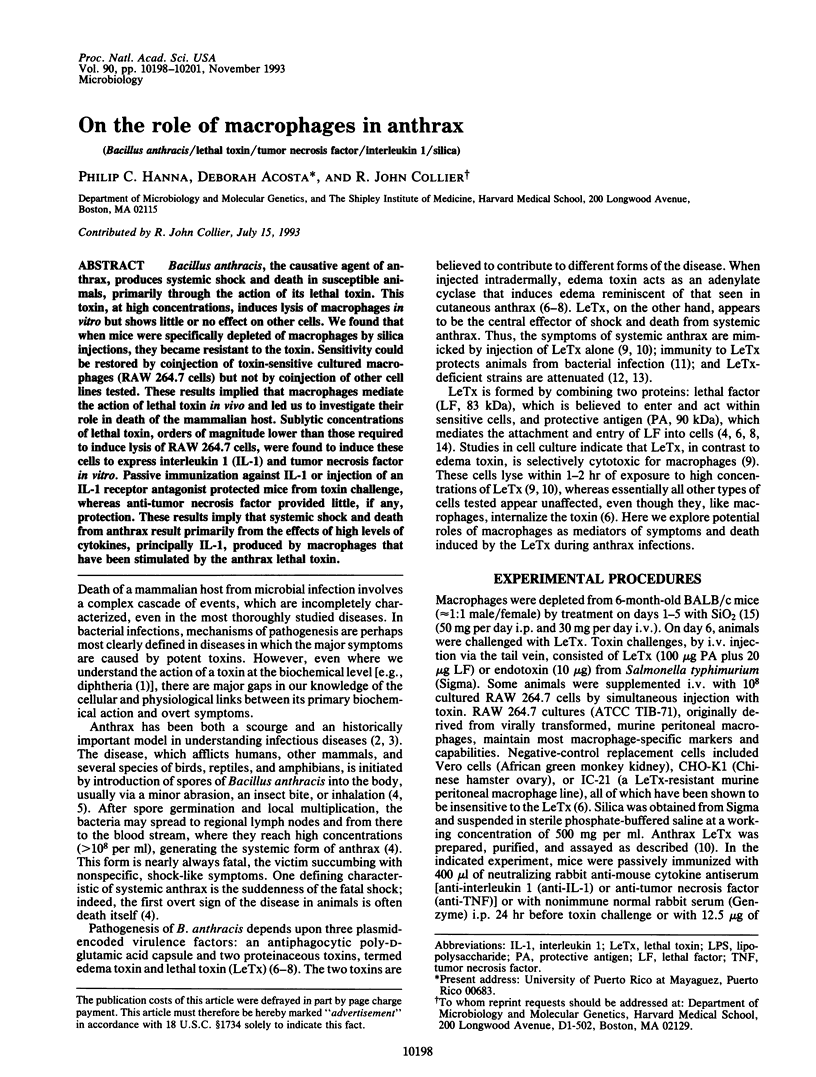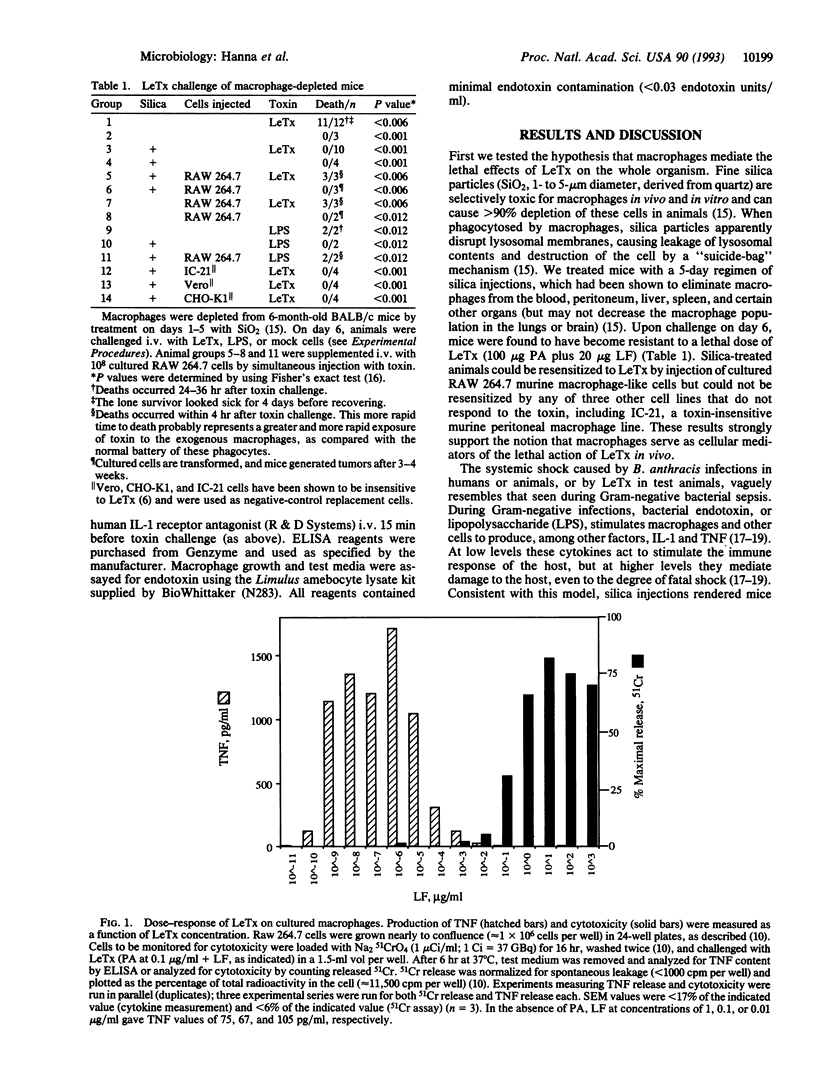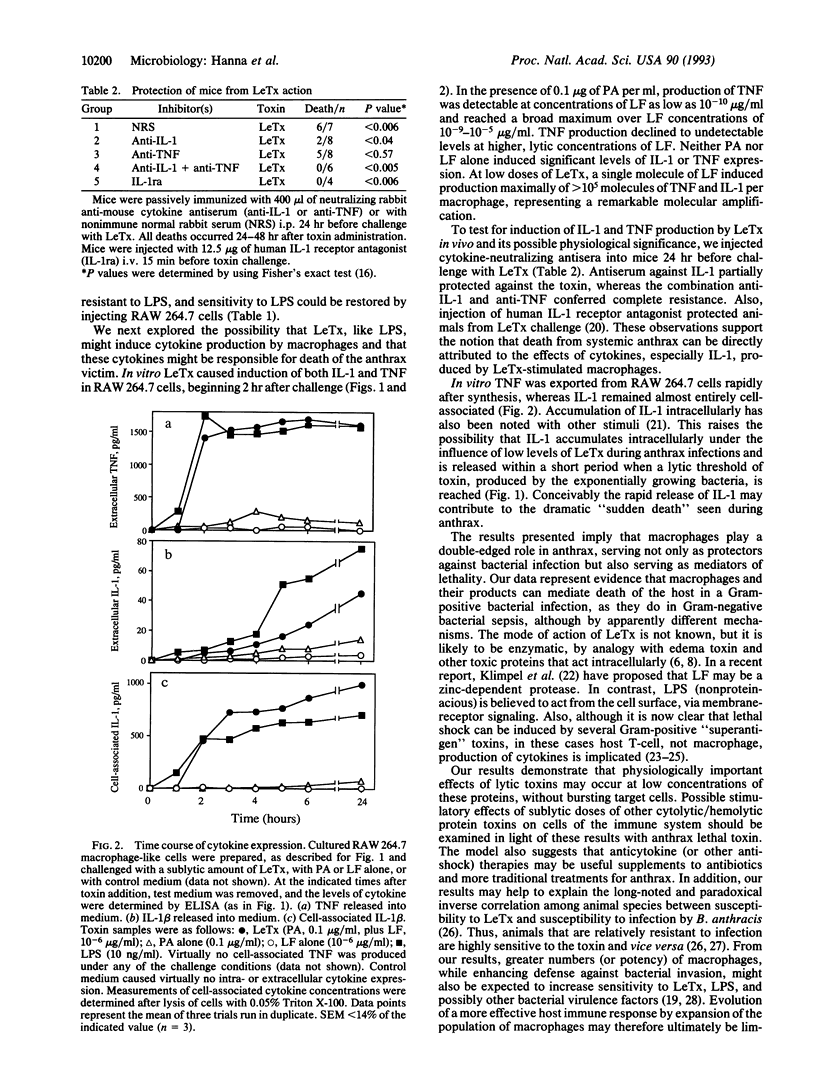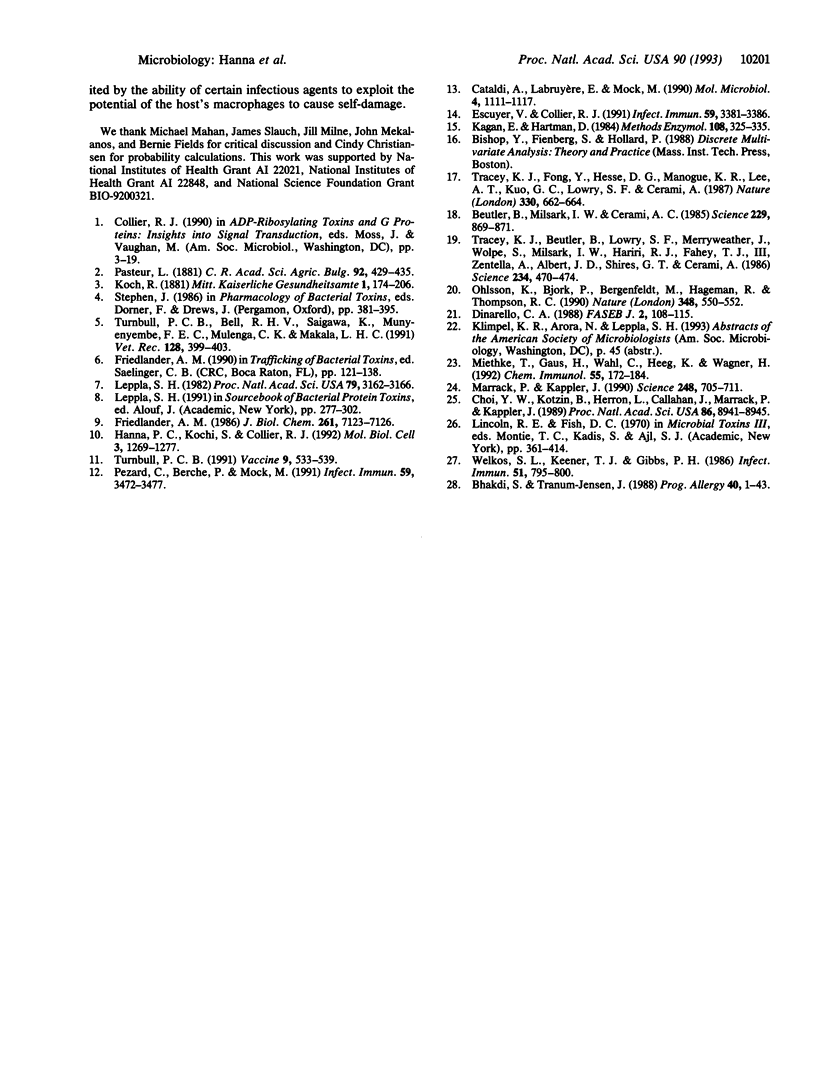Abstract
Bacillus anthracis, the causative agent of anthrax, produces systemic shock and death in susceptible animals, primarily through the action of its lethal toxin. This toxin, at high concentrations, induces lysis of macrophages in vitro but shows little or no effect on other cells. We found that when mice were specifically depleted of macrophages by silica injections, they became resistant to the toxin. Sensitivity could be restored by coinjection of toxin-sensitive cultured macrophages (RAW 264.7 cells) but not by coinjection of other cell lines tested. These results implied that macrophages mediate the action of lethal toxin in vivo and led us to investigate their role in death of the mammalian host. Sublytic concentrations of lethal toxin, orders of magnitude lower than those required to induce lysis of RAW 264.7 cells, were found to induce these cells to express interleukin 1 (IL-1) and tumor necrosis factor in vitro. Passive immunization against IL-1 or injection of an IL-1 receptor antagonist protected mice from toxin challenge, whereas anti-tumor necrosis factor provided little, if any, protection. These results imply that systemic shock and death from anthrax result primarily from the effects of high levels of cytokines, principally IL-1, produced by macrophages that have been stimulated by the anthrax lethal toxin.
Full text
PDF



Selected References
These references are in PubMed. This may not be the complete list of references from this article.
- Beutler B., Milsark I. W., Cerami A. C. Passive immunization against cachectin/tumor necrosis factor protects mice from lethal effect of endotoxin. Science. 1985 Aug 30;229(4716):869–871. doi: 10.1126/science.3895437. [DOI] [PubMed] [Google Scholar]
- Bhakdi S., Tranum-Jensen J. Damage to cell membranes by pore-forming bacterial cytolysins. Prog Allergy. 1988;40:1–43. [PubMed] [Google Scholar]
- Cataldi A., Labruyère E., Mock M. Construction and characterization of a protective antigen-deficient Bacillus anthracis strain. Mol Microbiol. 1990 Jul;4(7):1111–1117. doi: 10.1111/j.1365-2958.1990.tb00685.x. [DOI] [PubMed] [Google Scholar]
- Choi Y. W., Kotzin B., Herron L., Callahan J., Marrack P., Kappler J. Interaction of Staphylococcus aureus toxin "superantigens" with human T cells. Proc Natl Acad Sci U S A. 1989 Nov;86(22):8941–8945. doi: 10.1073/pnas.86.22.8941. [DOI] [PMC free article] [PubMed] [Google Scholar]
- Dinarello C. A. Biology of interleukin 1. FASEB J. 1988 Feb;2(2):108–115. [PubMed] [Google Scholar]
- Escuyer V., Collier R. J. Anthrax protective antigen interacts with a specific receptor on the surface of CHO-K1 cells. Infect Immun. 1991 Oct;59(10):3381–3386. doi: 10.1128/iai.59.10.3381-3386.1991. [DOI] [PMC free article] [PubMed] [Google Scholar]
- Friedlander A. M. Macrophages are sensitive to anthrax lethal toxin through an acid-dependent process. J Biol Chem. 1986 Jun 5;261(16):7123–7126. [PubMed] [Google Scholar]
- Hanna P. C., Kochi S., Collier R. J. Biochemical and physiological changes induced by anthrax lethal toxin in J774 macrophage-like cells. Mol Biol Cell. 1992 Nov;3(11):1269–1277. doi: 10.1091/mbc.3.11.1269. [DOI] [PMC free article] [PubMed] [Google Scholar]
- Kagan E., Hartmann D. P. Elimination of macrophages with silica and asbestos. Methods Enzymol. 1984;108:325–335. doi: 10.1016/s0076-6879(84)08099-x. [DOI] [PubMed] [Google Scholar]
- Leppla S. H. Anthrax toxin edema factor: a bacterial adenylate cyclase that increases cyclic AMP concentrations of eukaryotic cells. Proc Natl Acad Sci U S A. 1982 May;79(10):3162–3166. doi: 10.1073/pnas.79.10.3162. [DOI] [PMC free article] [PubMed] [Google Scholar]
- Marrack P., Kappler J. The staphylococcal enterotoxins and their relatives. Science. 1990 May 11;248(4956):705–711. doi: 10.1126/science.2185544. [DOI] [PubMed] [Google Scholar]
- Miethke T., Gaus H., Wahl C., Heeg K., Wagner H. T-cell-dependent shock induced by a bacterial superantigen. Chem Immunol. 1992;55:172–184. [PubMed] [Google Scholar]
- Ohlsson K., Björk P., Bergenfeldt M., Hageman R., Thompson R. C. Interleukin-1 receptor antagonist reduces mortality from endotoxin shock. Nature. 1990 Dec 6;348(6301):550–552. doi: 10.1038/348550a0. [DOI] [PubMed] [Google Scholar]
- Pezard C., Berche P., Mock M. Contribution of individual toxin components to virulence of Bacillus anthracis. Infect Immun. 1991 Oct;59(10):3472–3477. doi: 10.1128/iai.59.10.3472-3477.1991. [DOI] [PMC free article] [PubMed] [Google Scholar]
- Tracey K. J., Beutler B., Lowry S. F., Merryweather J., Wolpe S., Milsark I. W., Hariri R. J., Fahey T. J., 3rd, Zentella A., Albert J. D. Shock and tissue injury induced by recombinant human cachectin. Science. 1986 Oct 24;234(4775):470–474. doi: 10.1126/science.3764421. [DOI] [PubMed] [Google Scholar]
- Tracey K. J., Fong Y., Hesse D. G., Manogue K. R., Lee A. T., Kuo G. C., Lowry S. F., Cerami A. Anti-cachectin/TNF monoclonal antibodies prevent septic shock during lethal bacteraemia. Nature. 1987 Dec 17;330(6149):662–664. doi: 10.1038/330662a0. [DOI] [PubMed] [Google Scholar]
- Turnbull P. C. Anthrax vaccines: past, present and future. Vaccine. 1991 Aug;9(8):533–539. doi: 10.1016/0264-410x(91)90237-z. [DOI] [PubMed] [Google Scholar]
- Turnbull P. C., Bell R. H., Saigawa K., Munyenyembe F. E., Mulenga C. K., Makala L. H. Anthrax in wildlife in the Luangwa Valley, Zambia. Vet Rec. 1991 Apr 27;128(17):399–403. doi: 10.1136/vr.128.17.399. [DOI] [PubMed] [Google Scholar]
- Welkos S. L., Keener T. J., Gibbs P. H. Differences in susceptibility of inbred mice to Bacillus anthracis. Infect Immun. 1986 Mar;51(3):795–800. doi: 10.1128/iai.51.3.795-800.1986. [DOI] [PMC free article] [PubMed] [Google Scholar]


